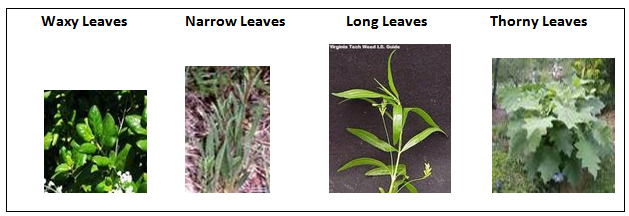Begin the lesson by reminding students why animals use adaptations. Ask students to explain why plants have structural, but not behavioral, adaptations. Discuss with students how they believe plants use adaptations. Record their responses using the Plant Adaptations Worksheet (see S-4-2-3_Plant Adaptations Worksheet in the Resources folder) as either a transparency or by projecting it on an interactive whiteboard. This serves as a pre-assessment to see what students already know about plant adaptations.
Read aloud to the class the introduction section of Seeds, Stems, and Stamens: The Way Plants Fit into their World by Susan Goodman. If the book is unobtainable, refer to the “What Do Different Plant Parts Do?” Web site found at www.mbgnet.net/bioplants/parts.html. Return students’ attention to the Plant Adaptations Worksheet transparency and ask students to give any other additional information they learned about why plants use adaptations.
Collecting Leaves Activity

Inform students that they will be collecting as many different leaves as possible from their homes. Instruct students to wear gloves for collecting thorny leaves to protect them from being stuck by thorns or cut. Have students collect leaves of different shapes and sizes and bring them in the following day to class.
Have students group the leaves together based on shared adaptations. Leaves can be grouped together as large leaves, small leaves, waxy leaves, thorny leaves, and long and narrow leaves.

Place different groups of leaves on different desks around the room. Travel around the room with students, pausing to view each desk with leaves. Review and explain the adaptations for each group of leaves.
Have students use their notebooks or journals to record student experiences with different types of leaves. This is a note-taking opportunity for students to define waxy, thorny, narrow, and longleaves. The use of pictures will also provide an opportunity to differentiate instruction to make sure all students master the learning objectives.
Have students complete the Create a Leaf Worksheet (S-4-2-3_ Create a Leaf Worksheet.doc) to review what they have learned. One of the questions on the worksheet asks students to draw a picture of a leaf that does not look appetizing to a predator. Students may have difficulty with visualizing a leaf that tastes bad to predators, but have students pretend to be a predator and design a leaf that would not look or taste good to them.
After completion, have students cut out their leaves. Then have them group the leaves together based on their adaptations.
Extension:
-
For students requiring extra practice with the standards, this adaptation can allow students to understand the big idea as well as extend the expectations of the lesson. Group students into teams of three or four and allow them to find out from literature, pictures, teacher/classmates, and Web sites about plant adaptations. Ask students to organize their notebooks into four sections. They will fold a notebook page in half. On the front page, label page halves as “Literature” and “Pictures.” On the opposite side, label the halves “Web sites” and “Teacher/Classmate.” As students do their research, have them fill in information in the appropriate sections.

By the end of this lesson, each student should understand how plants use adaptation to survive and why plants have different structural characteristics in various environments.
